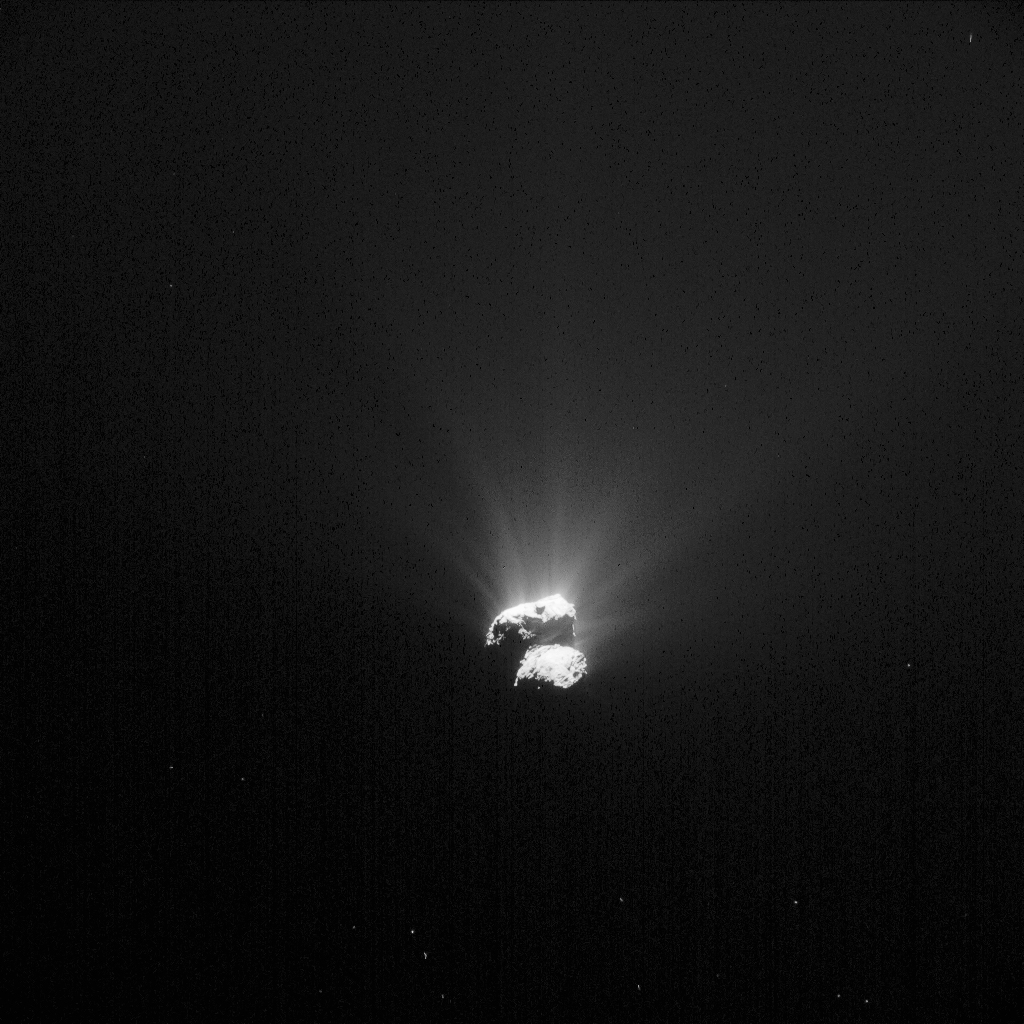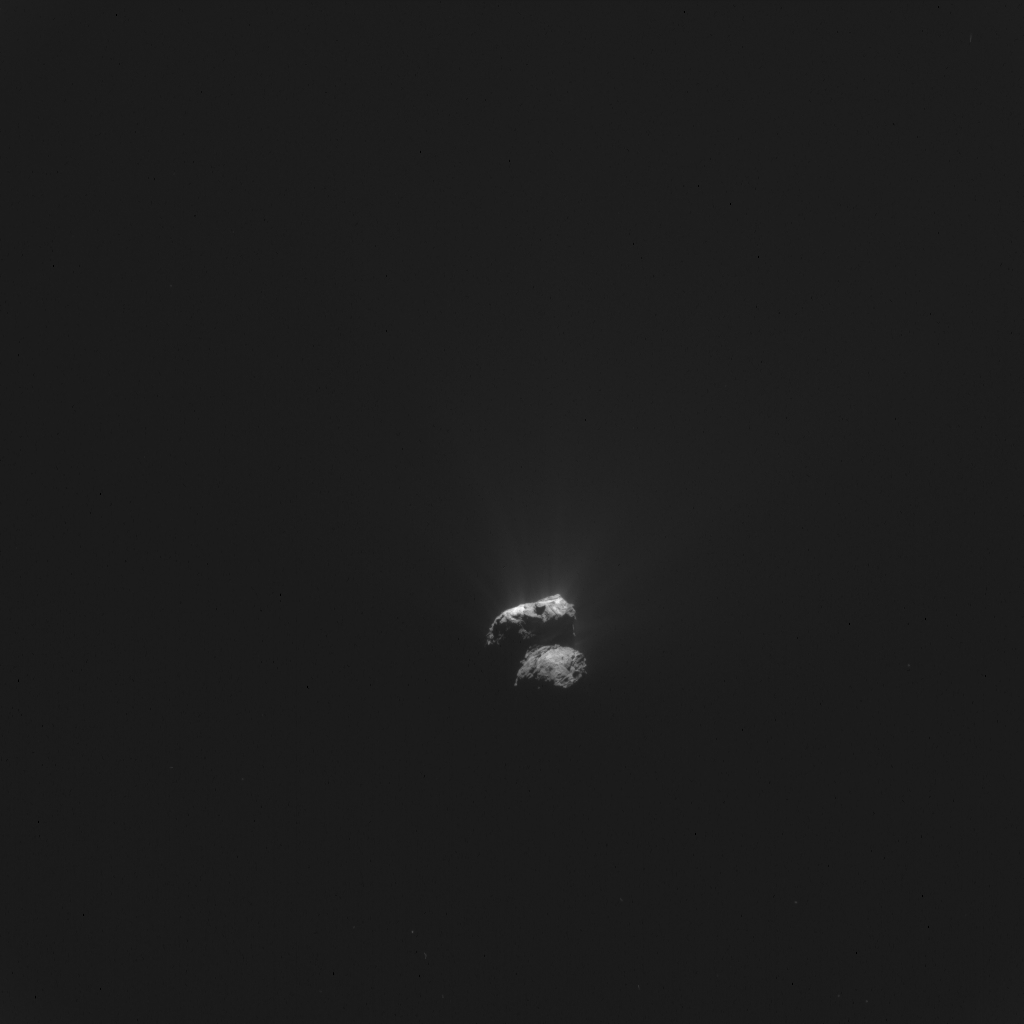Today’s CometWatch entry is an image of Comet 67P/Churyumov-Gerasimenko taken by Rosetta’s NAVCAM on 26 August 2015, about 415 km from the nucleus.

NAVCAM image of Comet 67P/C-G taken on 26 August 2015, about 415 km from the comet centre. Credits: ESA/Rosetta/NAVCAM – CC BY-SA IGO 3.0
The scale is 35.4 m/pixel and the image measures 36.2 km across. The contrast was increased to reveal the full extent of the comet’s activity.
This view shows the southern hemisphere of 67P/C-G, which had remained in darkness for over five and a half years until seasons changed on the comet in May. Currently, the southern hemisphere is experiencing a short summer, which will last about 10 months, until early 2016.
Ever since, several portions of the comet’s surface that were previously cast in shadow were revealed, allowing scientists to identify four new regions on the nucleus of 67P/C-G.
In today’s CometWatch image the larger of the two comet lobes points up and the smaller lobe down. On the large lobe, parts of the recently identified region Anhur are visible at the centre, with Anubis and Atum on the right and Aker on the left. Of the other newly named regions, Khonsu is located towards the upper edge of the large lobe in this view, hints of Sobek can be seen on the neck, and Wosret is well in sight on the small lobe.
You can find a regional map here, to help find your way around the southern hemisphere of the comet.
The original 1024 x 1024 image of today’s CometWatch is provided below:










Discussion: 10 comments
Would you dare, Brave People of The Bridge, on the final months of the Mission, to approximate one of the remaining moonlets? 🙂
Honoris causa Philae!
On visiting the library 68 at ESAC there is a general feeling of an ‘attachment’ in between the nucleus and immediate gas column [500m]. As if that near gas envelope being a continuation of the nucleus.
https://imagearchives.esac.esa.int/index.php?/category/68/
Gas fluidized dust beds acting on a slope could be drawing ‘dunes’.
Some superficial structures act as loose material ‘dams’. When broken causing ‘floods’.
In places where fresh material is exposed -as in neck’s pile-ups or around recent outbursts- ionizing is also strongly occurring at surface.
ROS_CAM1_20150201T220044.
Relatively speaking, hardly any activity at all in the original image compared to the bright outbursts we have seen recently and which required no image enhancement, in fact which were heavily saturated. The sublimation hypothesis requires the nucleus to be at its most active now, and quite simply it is not. It has been variable during the perihelion phase by several orders of magnitude. No comment from ESA on this very significant behaviour in relation to the favoured hypothesis. Will it brighten again or will it fade away. How is the variability explained. How can it brighten and fade so extremely by releasing gas.
Outbursts are short activity peaks. It’s clear, that before and after such a peak we see less activity than during the outburst.
The variability is explained by a sudden release of volatiles and supervolaties sublimated in subsurface cavities, until the pressure of these gases disrupt the walls of the cavity, which separate the interior of the cavity from free space.
Sudden expansion and release of gas drags debris.
Why do the supervolatiles sublimate? By medium-term solar heating. Diurnal temperature oscillations are averaged out in the deeper subsurface, but the mean deeper subsurface temperature is still increasing due to heat conduction.
Deeper layers are richer in supervolatiles, hence we see more of them shortly after the outburst, whereas water vapor doesn’t change pretty much.
Why are deeper layers richer in supervolatiles than shallow layers? Shallow layer have already been exposed to higher temperatues by solar heating, making most supervolatiles already lost by sublimation.
Confident hyothesising Gerald but it does depend rather strongly on the presence of the ice, the “supervolatiles” and the cavities being confirmed. These facts we still await. And we still await any data at all that throws any light on the origin or composition of the jets or the composition of the nucleus.
Is philae lost or not?
Please present science facts ASAP
Maybee because is a very different comet from Halley. Comets -quite probably- are among the most diverse objects in the neighborhood.
About variability, OriginalJohn.